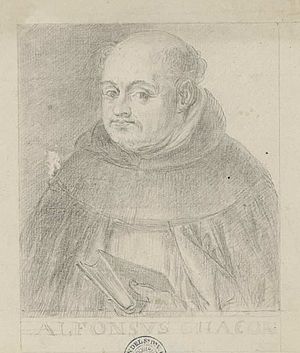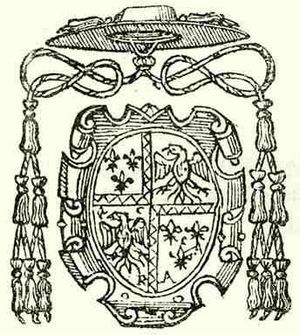Alphonsus Ciacconius facts for kids
Quick facts for kids
Alphonsus Ciacconius
|
|
|---|---|
 |
|
| Born | c. 15 December 1530 Baeza (Crown of Castile) |
| Baptised | 15 December 1530 |
| Died | 14 February 1599 Rome, Papal States |
| Occupation | Church historian, antiquarian, archaeologist |
Don Alphonsus Ciacconius was a Spanish scholar who lived a long time ago. He was born around December 15, 1530, in Baeza, Spain. He passed away on February 14, 1599, in Rome, Italy.
Alphonsus Ciacconius was a member of the Dominican Order, which is a group of priests and brothers in the Catholic Church. He spent much of his life studying and writing in Rome. You might also see his name spelled as Alfonso Chacón or Ciacono.
He is mostly known for two important books he wrote. These books covered history, especially about ancient wars and the lives of popes and cardinals.
Alphonsus Ciacconius's Studies and Books
Alphonsus Ciacconius was very good at understanding old writings and history. He was an expert in several areas:
- Ancient Writings: He studied epigraphy, which is the study of old inscriptions carved into stone or metal. He looked at writings from ancient Greece, Rome, and early Christian times.
- Old Manuscripts: He also knew a lot about paleography, which is the study of old handwriting and manuscripts. These are books or documents written by hand before printing presses were common.
- History of Popes: A big part of his work was researching the history of the papacy, which means the history of the popes, who are the leaders of the Catholic Church.
Understanding Colors in Coats of Arms
Alphonsus Ciacconius also had an interesting system for describing the colors used in heraldry. Heraldry is the study of coats of arms, which are special designs used by families or groups.
He used letters to stand for different colors, called "tinctures":
- A stood for Aurum, which means gold.
- a stood for Argentum, which means silver or white.
- c stood for Caeruleus, which means blue.
- r stood for Rubeus, which means red.
- v stood for Viridis, which means green.
Even though he didn't have a letter for black (niger), it was usually shown simply by using the color black itself. This system helped people understand and draw coats of arms correctly.
See also
 In Spanish: Alfonso Chacón para niños
In Spanish: Alfonso Chacón para niños
- Tricking (heraldry)



